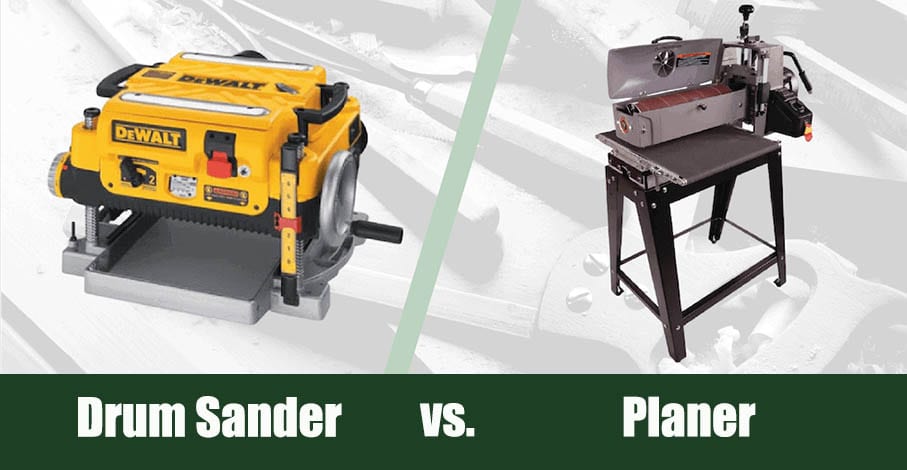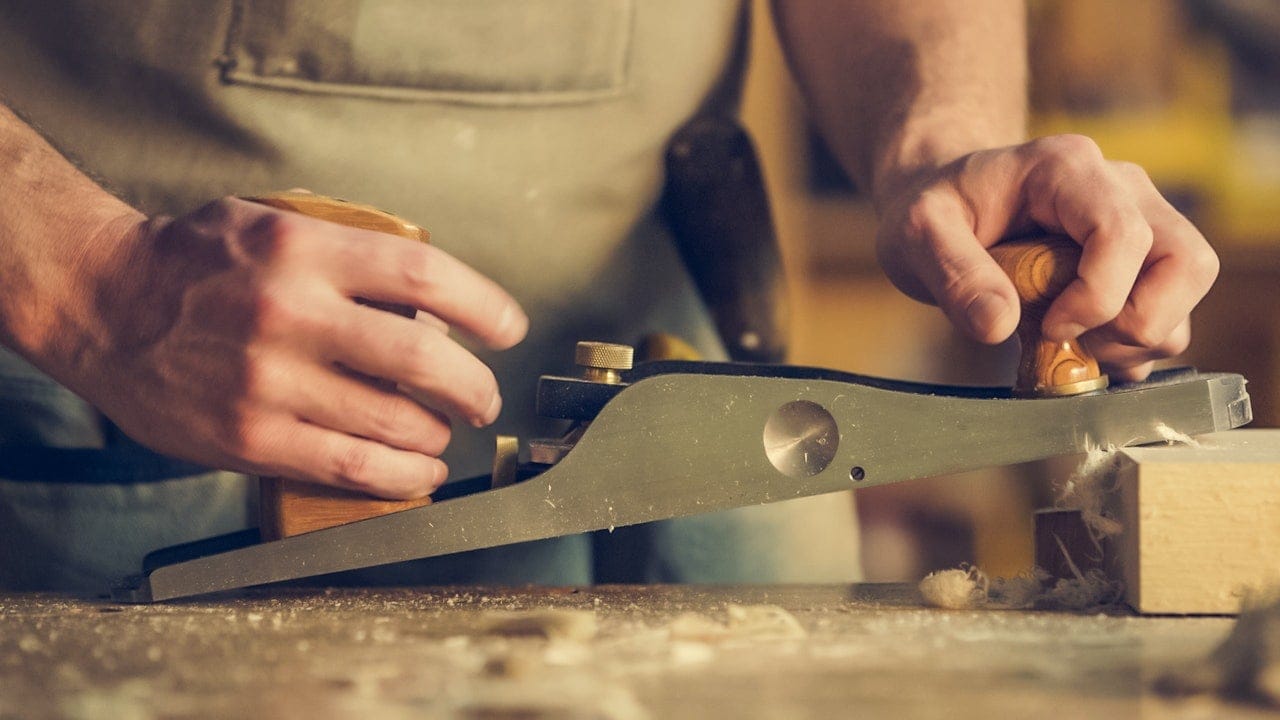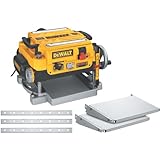Drum Sander vs Planer – Which is Best for Your Needs?
-
- Last updated:


If you build many woodworking projects, you often work with boards that can have a different depth of thickness. Creating boards that are a consistent level of thickness can cause quite the headache if you don’t have the proper tool.
Luckily there is help if you find yourself with this problem. There are two tools to choose from, the planer and the drum sander. Both tools’ purpose is to remove wood but they use different methods.
We will discuss each tool so you can make the best decision for your workshop.

Drum Sander
A drum sander is a large sander that uses a rotating sanding drum. The drum sander typically has a wide workstation that allows the user to work with larger pieces of wood. The tool is used for sanding wood for finishing but also can be used to shave layers of wood off for leveling. This tool can be useful when dealing with slightly warped or misshapen wood.

Basic Functions
The basic function of a drum sander is stated in its name, sand. The drum sander is used to sand down wood for finishing of projects. The way the drum sander operates is for the user to add sandpaper to the machine. The user can select the grit that is most desired for their need depending on the project. Remember, the lower number of grit, the more abrasive the sandpaper. Based on the grit the drum sander can simply sand as desired, or be used to cut down and level pieces of wood. The user selects the height for the first pass by adjusting the machine to the fit of the wood being worked with. This is where the user can sand to a fine finish or decide to take a little more off the top.
Safety
There are two main safety concerns when discussing a drum sander. The first is heat. Drum sanders can run incredibly hot. Both the machine and the wood that is run through the machine can burn if handled improperly. While operating a drum sander the user should wear gloves as a precaution. Users should also wait and let the machine cool before replacing any sandpaper. The second safety concern is the speed of the machine. Because the machine runs a t a high rate of speed the user must be careful with their fingers and must also watchout for having any piece of loose clothing or long hair getting caught in the machine. Along with these two key areas, standard safety protocols should be kept in mind and followed such as wearing protective eyewear and a dust mask.
Price
Drum sanders are very useful tools but they are also on the expensive side. Drum sanders can range in price anywhere from $700, which is a smaller model, up to around $1,200 for larger models. There are some drum sanders that also sell stands to go along with the machine, of course these are sold with an additional cost.
- Smooth, clean finish
- Adjustable height and speed
- Efficient for large projects
- Replacing sandpaper can be burdensome
- Price- they are expensive
- See Also: 5 Best Drum Sanders

Planer
A planer is used to remove layers of thickness from a piece of wood. Planers use a blade to cut wood at a high rate of speed which gives a clean even cut. The tool can be found in all sizes, from hand planers that are great for small projects to industrial-sized planers used for large sheets of wood. Planers are useful because they allow for an even cut at a desired thickness. This allows users to work with any size wood you might find anywhere, meaning you don’t have to throw out old furniture, you can reclaim the wood with a planer.

Basic Functions
The basic function of a planer is to make woodworking easier by creating pieces of wood that are cut to a desired thickness. They make boards flat, smooth, and even. A planer operates on a high level of horsepower and runs at a fast speed which makes it an excellent tool to level boards quickly. Using a planer can be as simple as feeding boards through the tool for large planers, or running a handheld planer over a board. The planer can be adjusted, typically by turning a knob, by the user to cut a desired depth. When using a planer it is best to make shallow passes rather than run the risk of cut marks or snipes, especially for a beginner user.
Safety
Planers use blades to cut wood so it is important to make sure to keep body parts, loose clothing, and other objects out of the path of the planer. They also run at a fast rate of speed so it is important to treat the tool with respect and not get careless. Another important safety issue is to make sure that the wood or boards being used are free of nails, staples, or screws. As with all power tools, the user should wear proper protection in the form of eyewear and a dust mask. Some electric hand planers can be loud so it also would be a good idea to have ear protection.
Price
Because there is a vast variety of planers there is a wide price range. Hand planers can cost around $20, while electric handheld planers can cost anywhere from $40-$90. Benchtop planers are much larger and therefore, can cut large pieces of wood at one time but they are more expensive ranging anywhere from $300 to over $1000.
- Works on all types of wood
- Quick cutting rate
- Adjustable cut depth
- Easy to use (after practice)
- Can create cut and snipe marks
- Can’t remove defects from wood surface

A Quick Glance at Our Favorites in 2024
- CAPACITY: Included infeed/outfeed tables provide 37-1/2 inches of support for the workpiece.
- AUTO ADJUSTMENTS: Feed logic system monitors the drum motor and regulates the speed of the conveyor motor.
- STORAGE: Closed stand with storage for keeping your abrasives organized.
- Purchase includes one stationary 13" Planer, in/out feed tables with fasteners (attached to the base of the Planer base), extra blades...
- Three knife cutter head of the thickness planer delivers 30% longer knife life and makes knife change faster and easier
- Two-speed gear box of the wood planer allows users to change feed speed to optimizing cuts per inch at 96 or 179 CPI
In Conclusion
At this point, you may be asking yourself “What is the best fit for me?” The answer depends on a couple of factors. Keep in mind that both the planer and drum sander can level wood and make boards an even depth. The difference is that the purpose of the planer is to cut wood to size, and the purpose of the drum sander is to sand. If you’re looking to create a different depth for the wood, especially thick pieces, the planer would be the tool to use. If you’re looking for smooth fine finishes, the drum sander would be the right tool.
A second factor to look at would be how much you’re willing to spend. Both machines are wonderful to have but they can be expensive, especially the drum sander. It is important to know what you’re looking to do and use your tools the proper way to avoid any undue wear and tear that could cause the machine to break down causing an extra cost, or even worse cause an injury.
The planer and drum sander are both powerful tools for any woodworker to have in their arsenal. They both have a place in any workshop. Either machine can help create great-looking projects and save time during the building process.
Featured Image Credit: Pikrepo
Contents



